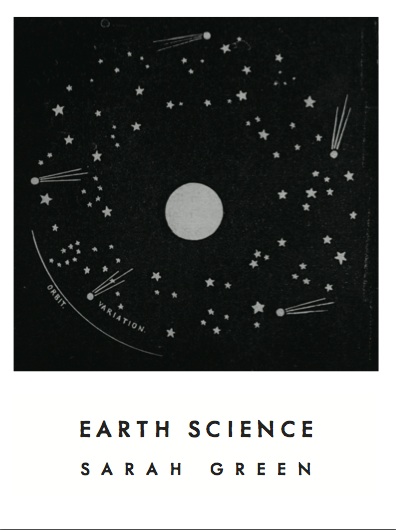Earth Science – Sarah Green
Claire Eder

Wary Exuberance: Sarah Green’s Earth Science
One time, I got into a debate with another writer over whether or not spring was an asshole. In Appalachian Ohio, the dogwoods were blooming uproariously, the ground was carpeted with flowering moss, and the robins were plump and scuffling with one another. I was getting tired of being jerked around and falling in and out of love, always this time of year, when the earth wouldn’t sit still anymore. I quoted Edna St. Vincent Millay’s poem “Spring”:
To what purpose, April, do you return again?
Beauty is not enough.
You can no longer quiet me with the redness
Of little leaves opening stickily.
I know what I know.
……………………………………………
It is not enough that yearly, down this hill,
April
Comes like an idiot, babbling and strewing flowers.
The writer said, “But at least spring’s sincere, isn’t it? It doesn’t know any better. How can you not be taken in by it?”
Can spring still be an asshole even if it doesn’t mean to be one—if it’s propelled by forces larger than itself? I ask this question about some of the people I know. Sometimes I ask it about myself.
Sarah Green, like me, is wary of spring. Her poem “I Can’t Stop It” begins:
That jonquil spray:
notes from a bird
lilac and soil
I can’t stop it from reaching me
Invisible staff clef
thrusting its pistil melody
due to some genes
It can’t stop it either
As other poems in Earth Science, Green’s first book, reveal, she is wary of many things, like time, memory, joy, and her own gorgeous images. Green is wary in the way I think all poets should be wary: always questioning her own representation of experience. She owns that poetry deals in the manipulation of emotions. She’s got a conscience, she worries about manipulating people, but of course she knows that readers want and expect to be manipulated, to be transported. She urges us to stay awake, to not get had:
Why aren’t we all
a little more anxious
re: beauty
re: Helen launching our ship
continually
whether our ship’s ready or not
Beauty is always making us do things, feel stuff. It’s exhausting, and how can we say that we have any choice in how our lives turn out? The poems in Earth Science grapple with the forces underneath that which we see as the self, an event, or a memory. How to narrate one’s life if the self is a hodgepodge of influences, manipulated at every turn, constantly transforming? We can’t stop smelling the flowers.
In addition to being standoffish about beauty, Green has a habit of stepping outside of her memories because she wants to know the absolute truth of what happened to her, and she can’t, and it’s driving her crazy. She begins a poem about being chased by a donkey in rural Burgundy: “That donkey— / there’s so much I don’t know about my life.” Was the donkey an adolescent or fully grown? Was he charging because he was a serious guard donkey or because he was a jokester, just trying to psych her out? How can she tell the story—and it’s such a good story!—if she really has no handle on the truth of that donkey’s existence and of her own brief intersection with it?
But the unknowable is Green’s lodestar. She describes two ex-lovers avoiding each other at a party as
Constellations, I think—one law
keeps us from moving closer. Another says
we have to share a hemisphere.
We’re not famous, though.
We don’t have real names.
Try to see us, we’re hidden by clouds.
In the attempt to narrate the self, experience is always fixed yet moving, shining yet obscured. The dilemma and the blessing is that change happens so quickly: we pass between versions of self in the blink of an eye. In “There’s Been a Miscommunication about My Past Snake Skins,” Green writes,
I didn’t intend them for the town archive.
They don’t apply, now, to this me.
I intended to slip away and down a riverbank
and through a log, or a tire. Some reeds—
I left so many skins.
Don’t gather them. Don’t come looking.
I’m in a field, feeling ready to be a different snake.
Snake 17.
Gathering the skins—connecting points in time like stars in a constellation—is impossible. We can attempt to interpret our experience and claim memory as truth, but we are always already in the midst of becoming a new snake. A poem tries to hold on while the Protean self turns first into an electric eel, then a hedgehog with spikes engaged, then a snarling jaguar. The poems in Earth Science succeed because they acknowledge their own impossibility. Like Millay, Green knows that “Beauty is not enough”—it must be interrogated. Helen may keep launching our ship, but we should at least break our own bottles over the hull.
Another night soon after our debate about spring, I saw the writer strolling under the flowering trees lining our small town’s main road, clutching a magnolia blossom to his nose—really, burying his nose in it. From across the street, I first took it for a wad of tissue. Allergies, I figured. Spring, that asshole. The cool night air tried to charm me with its green scent, and I tried to stand off, but the writer was correct, spring didn’t know any better, and I marveled at him and his acceptance of all that reckless beauty. He was grasping the change, and he was holding on to it.
Claire Eder’s poems and translations have appeared in [PANK], Midwestern Gothic, the Common, and Guernica, among other publications. She graduated from the University of Florida’s MFA program and is currently pursuing a PhD in poetry at Ohio University.









